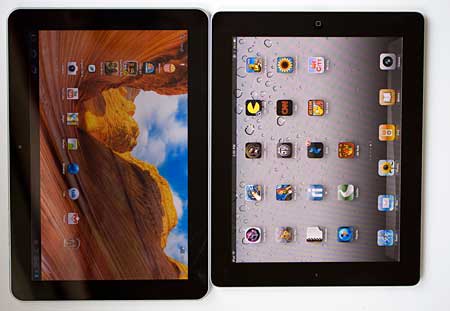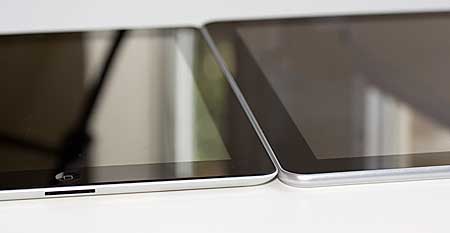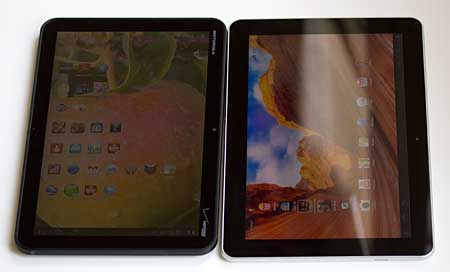The tablet has a front 2.0 megapixel video chat camera and a rear 3 megapixel camera with LED flash. Most tablets have a 5 megapixel rear main camera, but we give Samsung the nod for getting the most out of 3 megapixels. Photos are decent with good exposure, color balance and color saturation. We’ll take the Samsung camera over the 5 megapixel Asus Eee Pad Transformer’s and Acer Iconia Tab A500’s. The main camera can shoot fairly decent 720p video and there’s a very basic video editor included. The front 2 megapixel video chat camera (a common resolution among 10” Honeycomb tablets) shoots good looking video in Google’s Gtalk video chat.
The Tab 10.1 has Bluetooth 2.1 + EDR and a healthy set of profiles including A2DP stereo and HID for Bluetooth keyboards (we tested a few and they worked fine). The Galaxy Tab 10.1 has a whopping 7,000 mAh Lithium Ion battery. We’re impressed that Samsung found a way to pack such a large battery into this waifish tablet. As you might guess, with that much battery inside, the 10” Tab runs as long as the Transformer on a charge, and can handle three feature films on a charge easily with brightness set at an adequate 50%.
Build quality is excellent and the industrial design is lovely. The power and volume control buttons are small but easy to operate and have a nice feel when operated. The headphone jack is up top, and Samsung’s proprietary connector is at the bottom. This is the same multi-function connector used in the 7” Galaxy Tab, and we expect cables to be interchangeable. Both ship with the same small gloss black charger that puts out much more current than a USB port (tablets have higher capacity batteries than phones, hence tablets need higher amp chargers).
The Tab’s back is gloss white, and Samsung lists a metallic gray version though we haven’t seen it. The back is plastic, so it loses quality and durability points compared to the Motorola Xoom and iPad 2, but that plastic is what makes it lighter. Though the build is excellent, the Tab is so slim that you can’t help but treat it gingerly. In comparison, the thicker metal-clad Motorola Xoom (also $599 for the 32 gig WiFi-only version) feels like it could be used as a weapon.
Samsung ships a USB cable that connects the tablet’s 30 pin connector to a standard USB port. The bad news is that Samsung didn’t opt for standard mass storage mode so the tablet could mount as a removable drive. Instead we have the horror that is Samsung Kies, the company’s oddball syncing protocol based on MTP that’s been such a headache on Samsung Android phones (which at least also had a USB mass storage mode). The Galaxy Tab 10.1 wouldn’t mount at all on any of our Mac OS X computers even though we had Google’s Android File Transfer app for Honeycomb tablets up and running.
We mostly got it to appear under My Computer with a few Windows 7 notebooks, but it was hit or miss. MTP (media transfer protocol) is supposed to make life easy when transferring content from Windows Media Player to a portable media player. We don’t think that’s the most appropriate way to handle what amounts to a computer stand-in. Samsung, this is not a pocket media player. With an Android tablet, you’re just as likely to want to transfer MS Office files, video taken with the tablet’s camera and other non-Windows Media Player content. The Tab, when it begrudgingly appeared under My Computer did all the weird things that MTP devices do under Windows, including telling you that you might not be able to browse another folder on the Tab while copying files at the same time, and offering to convert inappropriate items. Our laptops automatically installed drivers for Kies on first connect, but a serial driver failed, though things still (sort of) worked. Windows Update found a new version of the Kies driver, but it failed to download and install on two computers.
This leads to our complaint about the lack of a micro SD card slot and a USB host port. It’s not fun using the USB cable to transfer stuff in Samsung Kies mode. It would be nice to plug in a flash drive or micro SD card to get files on and off the device. Our Acer Iconia Tab does this, our Eee Pad Transformer has a micro SD card slot, the Motorola Xoom has USB host (though you really have to hunt for the proper cable) and will some day have a functional microSD card slot. Thank goodness for DropBox, for those of you who don’t mind storing files on the cloud. Like the iPad 2, your connection and file transfer options are limited, but at least it’s very easy to connect an iPad to a Mac or Windows PC.
Since the Galaxy Tab 10.1 runs standard Android 3.1 Honeycomb, there’s not much to be said for software. Samsung adds very little; heck there’s not even a demo game included, though they do include Quickoffice HD (an excellent tablet-centric Office suite) and Movie Studio (a very basic video editing app). Samsung Apps is a portal to Samsung apps (surprise) and third party apps. The tablet has only been on the market a few days, and Samsung Apps has only a few apps (mostly Angry Birds games). Sadly, Samsung’s Media Hub wasn’t ready in time for launch but Samsung says it’s coming. Media Hub is a TV show and movie rental and purchase portal run by Samsung. Unless Netflix releases a version of their app for the tablet, streaming and downloadable commercial TV and movie content with DRM is slim on the Tab 10.1 (the same is true of other Honeycomb tablets). When it comes to additional apps, the Android Market is here and you can download apps to your heart’s content. The selection of tablet apps on the Market is still very slim compared to the iPad’s, but we’ve found a few sharp 3D games, a good selection of news readers, Flixster, IMDB and plenty more to keep us productive and entertained.
In terms of speed, the Galaxy Tab 10.1 is quite fast and it’s as stable as other Honeycomb tablets (we see an occasional app crsh but nothing worse). Though it feels fast, handles Adobe Flash 10.3 with Tegra 2 hardware acceleration well, and plays 1080p video perfectly, its Quadrant Benchmark score is a surprisingly uninspiring 1504, though Linpack is pretty good at 31.
Conclusion
Looks count, and undeniably the Samsung Galaxy Tab 10.1 is the most attractive and slim Android tablet on the market. The iPad 2 has nothing on the Tab 10.1 in terms of looks and build quality other than the Tab’s plastic back that allows it to be lighter than Apple’s finest. The display is top notch with vivid colors, sharp text and plenty of brightness to tackle a bright room. The tablet is responsive, handles Adobe Flash and 1080p locally stored content well, and it runs Android tablet apps from the Market fine. We can’t help but miss what’s missing though: no microSD card slot, no standard USB port and no HDMI port. For the same price, the Motorola Xoom offers these and the Eee Pad Transformer has a card slot and HDMI for considerably less money. We could live without the expansion options if Samsung hadn’t foregone standard USB mass storage mode and made us suffer with Kies and the MTP protocol.
Price: $499 for the 16 gig version and $599 for the 32 gig version
Website: www.samsung.com/us/mobile/cell-phones |

Directly above and below: the Samsung Galaxy Tab 10.1 and the iPad 2.


The proprietary sync/charge/dock connector.

The Motorola Xoom and Galaxy Tab 10.1.

Above: the Samsung Galaxy Tab 10.1 on top of the Toshiba Thrive. |

